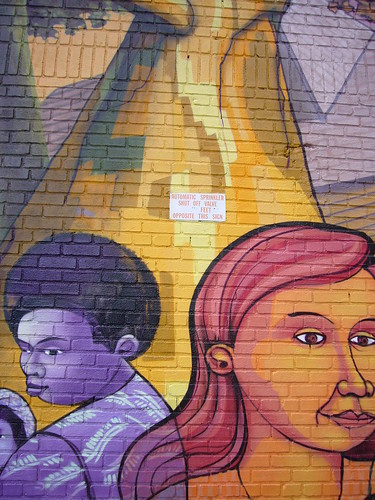
Is taking photos of abandoned places in America too often an act of nostalgia, and if so, what does that mean about the work? Is "urban exploration photography" an excercise in nostalgia?
Vanishing America: the End of Main Street: Diners, Drive-Ins, Donut Shops, and Other Everyday Monuments by photographer Michael Eastman prompts the question.
Vanishing America has received rave reviews, and Eastman is often compared to the
important and influential photographer Robert Frank.
There seems to be a good-sized group of photographers documenting the America of yesteryear. Sometimes this fits into my definition of urban exploration photography, and sometimes it doesn't. Michael Eastman straddles the dividing line, and in my opinion, it makes his work less spectacular.
Don't get me wrong: Eastman's photographs are quite nice, and his subject matters are worth documenting. But he's doing too much in
Vanishing America, in my opinion, and his supposed subject suffers for it.
Eastman divides subject matter into 10 chapters: Theaters, Churches, Hangouts, Doors, Signs, Stores, Services, Automobiles, Hotels, and Restaurants. There are photographers who could fill a book on one of these subjects, and have done so. (
Camilo Jose Vergara's How the Other Half Worships for churches;
Zoe Leonard's Analogue for storefronts) and many others who have done extensive work documenting the other subjects and could fill a book given the opportunity (
Roy Colmers' Doors, NYC, although dated and New York-based, is much more provoking and less architectural).
Having said that,
Vanishing America is supposed to be about Main Street, USA. Most of us miss Main Street, I think, from New York City to New Orleans, St. Louis to Tempe, AZ. But are all of these photos really from what was the Main Street in these cities? I have my doubts, and it's a small photo titled "Dinosaur Parts" outside Sedona, Arizona (p87) that reinforces my reasoning. I ride the route from Phoenix to Sedona almost annually, and this doesn't look like the Main Street of Sedona (which is still very much an active Main Street). It looks like new sculptures created to entertain. And "outside Sedona, Arizona" doesn't scream "Main Street". One photo I really like is the "Interior of a Bar, Clarksdale, Missippi", which serves as an unofficial centerfold of the book, printed on two pages (p122-3) and depicting cheap white blinds with marker writing on each slat ("Bananarama 2002"; "Bacon Luvs Da Blues"; "Rhonda W. Cheryl P. 8/20/05"). But it doesn't speak Main Street, and it isn't really from yesteryear, as indicated by visible dates.
Photos like "Fish, Pest Control, & Roofing, Saint Louis Missouri" (p91), "Geller's Shoes, Providence, Rhode Island" (p127), and "Along Highway 1, Guadalupe, California" (p94-5) do indeed support a theory that Main Street ain't what it used to be. But Eastman's desire to include interesting photos overrides his desire to provide a cohesive statement that isn't just nostalgia. Was "Red Building with Coke Sign, Southern Maine" (p190) really on a Main Street? (If so, wow, look at all of those TREES and SPACE.) And the one photo of NYC "Thirsty? (Slated for Demolition), Coney Island, New York" shows off the great Burlesque at the Beach paintings of Fire Eater and Madame Twisto, but this isn't really Main Street on Coney Island; it's a beach and boardwalk development.
Eastman's photos are nice, but the book could've been better by tighter selection and adhering to the thesis. This is nostalgia in full force.
Douglas Brinkley wrote the excellent foreword. so excellent that sections of it stand on their own, despite the constant crowing of Eastman's work.
I'm genetically predisposed to visit the same locales Eastman shares with us in his dreamlike Vanishing America. Where some might find gloom in these anti-Rockwellian photographs, I find a liberation from the glaring rat race of American life.
Or maybe it's best to think of Vanishing America as a book of Sunday photographs, since Sunday is the loneliest day of the week. Like in the Kris Kristofferson song "Sunday Morning Coming Down," I imagine Eastman surveying an empty Main Street while the new-fangled box-store churches on the outskirts of town are full of repenters. The murals he documents are not the kind Thomas Hart Benton erected to promote the vigorousness of Populist America.
I don't agree with everything Brinkley writes ("You're better off building a fire by the side of the road than trying to reclaim one of these hard-luck properties"; "Michael Eastman still needs to photograph your footprints"), but his essay is thought-provoking and ties the photos together in a way the photographs don't do themselves.
I will use Brinkley's voice to make a final critique of Eastman. Brinkley writes "There are no Tennessee waltzes or Texas two-steps vibrating out of these juke joints, no 'Happy Trails' to close out the day at the music hall." I disagree. There's a photo of the interior of the Broken Spoke, a honky tonk music venue in Austin Texas (p44) across from a photo of an unnamed "Dance Hall" (also in Austin, Texas). The Broken Spoke is indeed still very active and heralded venue, and the photo of the "Dance Hall" looks like a nicely upkept place as well. Austin, Texas loves Americana and to say these photos are part of a Vanishing America is simplistic. People are still living this every day (in this case, probably every weekend). The aesthetic might be different than "the norm" (of non-Austin locales), but that doesn't make it Vanished. In fact, these photos indicate that this culture is CURRENT. These photos, and several others, show that along with the REAL photos supporting Eastman's hypothesis, there are photos supporting Eastman's own aesthetic experience of buildings and status quo. Overall, not only is
Vanishing America a nostalgic experience, it's a nostalgic experience of Eastman's own thoughts and assumptions, many of which are stereotypical and simplistic.


